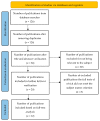Treatment Costs and Social Burden of Pancreatic Cancer
- PMID: 36980796
- PMCID: PMC10047484
- DOI: 10.3390/cancers15061911
Treatment Costs and Social Burden of Pancreatic Cancer
Abstract
(1) Background: Pancreatic cancer is the cancer with the third-highest mortality rate, and forecasts indicate its growing share in morbidity. The basis of treatment is inpatient chemotherapy and there is a strong focus on palliative care. (2) Methods: A literature review was conducted based on the rapid review methodology in PubMed and Cochrane databases. The search was supplemented with publications from the snowball search. Qualitative assessment of included publications was performed using AMSTAR2 modified scheme. (3) Results: The review included 17 publications, of which majority concerned direct costs related to the adopted treatment regimen. Most of the publications focused on comparing the cost-effectiveness of drug therapies and the costs of palliative treatment. Other publications concerned indirect costs generated by pancreatic cancer. They particularly focused on the economic burden of lost productivity due to sickness absence. (4) Conclusion: The increase in the incidence of pancreatic cancer translates into an increase in the costs of the health care system and indirect costs. Due to the significant share of hospitalization in the health care structure, direct costs are increasing. The inpatient treatment regimen and side effects translate into a loss of productivity for patients with pancreatic cancer. Among gastrointestinal cancers, pancreatic cancer generates the second largest indirect costs, although it has a much lower incidence rate than the dominant colorectal cancer. This indicates a significant problem of the economic burden of this cancer.
Keywords: economic burden; healthcare costs; indirect costs; pancreatic cancer.
Conflict of interest statement
The authors declare no conflict of interest.
Figures
References
-
- Zatoński W.A., Zatoński M., Janik-Koncewicz K., Połtyn-Zaradna K., Wijatkowska K., Marciniak A. Hundred years of cigarette smoking in Poland: Three phases of the tobacco epidemic. J. Health Inequal. 2017;3:118–122. doi: 10.5114/jhi.2017.74200. - DOI
-
- Pizot C., Dragomir M., Macacu A., Koechlin A., Bota M., Boyle P. Global burden of pancreas cancer: Regional disparities in incidence, mortality, and survival. J. Health Inequal. 2019;5:96–112. doi: 10.5114/jhi.2019.87844. - DOI
-
- Thallinger C., Belina I., Comanescu A., Cufer T., Jassem J., Kiesewetter B., Markaroff L., Ott R., Polinski B., Rasinar R., et al. Limitations of cancer care in Central and South-Eastern Europe: Results of the international conference organized by the Central European Cooperative Oncology Group (CECOG) J. Health Inequal. 2020;6:139–152. doi: 10.5114/jhi.2020.103221. - DOI
-
- Boccuzzi S.J. Indirect Health Care Costs. In: Weintraub W.S., editor. Cardiovascular Health Care Economics. Contemporary Cardiology. Humana Press; Totowa, NJ, USA: 2003. - DOI
-
- Badowska-Kozakiewicz A., Fudalej M., Kwaśniewska D., Durlik M., Nasierowska-Guttmejer A., Mormul A., Włoszek E., Czerw A., Banaś T., Deptała A. Diabetes Mellitus and Pancreatic Ductal Adenocarcinoma—Prevalence, Clinicopathological Variables, and Clinical Outcomes. Cancers. 2022;14:2840. doi: 10.3390/cancers14122840. - DOI - PMC - PubMed
Publication types
LinkOut - more resources
Full Text Sources


